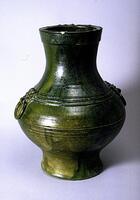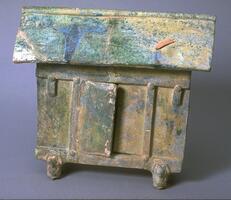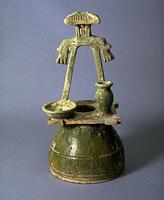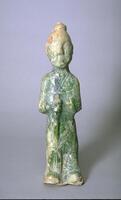Cabinet G: Shelf 1
Mortuary Art from China
Mortuary Art from China Throughout its long history, Chinese culture has continuously shown a special reverence for the deceased; this is rooted in the belief that the dead are still present and are able to influence life on earth. For many centuries, a tomb was considered a lasting home for the body, to be equipped with the same kinds of material goods that provided pleasure and comfort in life. Because buried artifacts are more likely to survive the passage of time, our most vivid and tangible understanding of ancient Chinese life often comes from objects excavated from tombs.
Ceramics have played a central role in tomb furnishings in many historical periods as storage containers for grain and wine and as ming qi, or “spirit goods.” Manufactured exclusively for tombs, ming qi are the miniature clay models of houses, livestock pens, animals, and humans that so delight us today for their charming recreation of village and city life. Ming qi first came into widespread use in the Han dynasty, partly as substitutes for human and animal sacrifices, but also as a reflection of a new, more practical worldview.
Guardian figures demonstrate another interesting aspect of Chinese mortuary culture. It was believed that after death the soul was freed from the body and could roam around the universe without hindrance; since family members did not like the idea of powerful ancestors, particularly those with unsettled grievances, wandering around freely, guardians were posted at the doorways of tombs to keep spirits from getting either out or in.
Created For
K-12 EducatorK-12 Student
Museum Visitor
UMMA Docent
UMMA Staff
University Faculty
University Student
Rate this Resource
AVG: 0 | Ratings: 0
& Author Notes
Creative Commons by-nc-saLast Updated
June 8, 2020 7:28 a.m.Report
Reporting Policy






